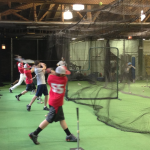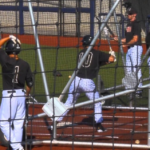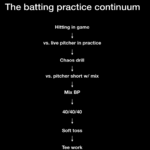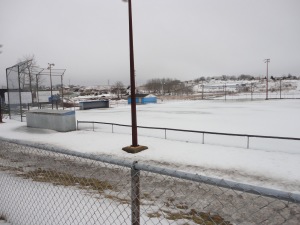Effective Planning of Indoor Baseball Practice
People who live in warm weather climates will not understand this post. “Why would you ever play baseball inside?” Well, in Chicago we’ve had at least an inch of snow on the ground (we have about 15 inches right now) for the last 40 days. Temperatures have generally hovered between -15 and 10 degrees for all of 2014, and long term models don't show an improvement that would melt all this snow.
The reality is, our baseball season will begin on March 3 with around a foot of snow on the ground and temperatures below freezing. There will not be much, if any, baseball practiced outside prior to our first game on March 22nd.
Some high schools, travel teams, and youth leagues are fortunate to have a nice field house facility and several batting cages at their disposal. We have a single gym that we will be sharing between basketball, three levels of baseball, and three levels of softball until it gets nice enough to go outside. We also have a balcony with a single indoor batting cage.
It sounds like I’m doing a lot of complaining so far (maybe just a little) but that is not the point of this post. The point is, many of my counterparts in the North will be in a similar situation this early spring. We basically have two options, let practice become stale and worthless, or be innovative and get the most out of limited practice space and time.
This post is intended to help coaches (and myself) organize their thoughts and priorities heading into their early spring season. It is next to impossible to simulate actual baseball in a gym. In a gym pitches don’t travel from 60 feet, balls bounce funny off the gym floor, and fly balls don’t get higher than 25 feet. Because of this, creating an environment where players and teams can improve is difficult.
Below are some tips for maximizing your indoor practice time:
Time - Our time is limited to an hour and a half every day because we have seven teams sharing our facility between 5:30-7:00 am and 3:00-9:00pm. Early in the season this can be troublesome, but as the indoor practices pile up, an hour and a half is just fine.
There is no reason to hold 3 hour long indoor practices. They will get stale regardless of what you do and players will get cabin fever. A long practice every once in a while is alright, but keep them to a minimum.
Instead, work on making your practices efficient so you can fit that 3 hour practice into 2 hours.
Have a plan - Coaches should always have a written practice plan, but the detail for an indoor plan needs to be more specific. Because of space limitations, having a specific diagram where each drills will take place and for how long will help create a smooth transition from one activity to the next and help ensure the safety of the players on your team.
Set up expectations ahead of time - The easiest way to set your early spring practices up for failure is to assume your players know what an indoor practice should look like, then get mad at them when they don’t execute the way you envisioned.
Prior to practice starting for the season, explain the pace of practice, the drills you want to cover, the techniques you want them to use, the expectations of players during practice, and anything else that will help your practices run smoothly and efficiently.
This will allow your team to hit the ground running and you won’t have to waste precious gym time talking.
Focus on skill development - Those of you who have been following me know that I am a HUGE proponent of teaching the tactical side of baseball. It is often under-coached, or not coached very well. We are creating a generation of “Showcase Players” who look great in the cage, throw hard, run fast, but don’t know how actually play the game.
Unfortunately, it is difficult to practice many tactics inside. How do you simulate cut offs and relays in a gym? Even infield tactics like bunt defenses and first and third defenses can be difficult to simulate in a gym. When we set up our infield, it is 90 x 74… not very realistic.
For that reason, skill development should be a huge component of your indoor practice plan. If you can teach technique inside, when you do get outside, that gives you the ability to move quickly into tactics.
As an example, working on cutoffs and relays in a gym is probably not happening, but you can implement the skills necessary for cutoffs and relays inside. Teach players to how to properly accept cutoffs, quick hands, throwing mechanics and footwork for outfielders, and infielders accepting throws at the bag and making tags while you are inside. This makes it a smoother transition when you can work this tactic outside.
Create a routine - Time is of the essence during an indoor practice. The biggest waste of time in any practice is transitioning between activities. Creating a routine, having all of your equipment set up ahead of time, and making sure everyone knows the plan going into practice will help minimize transition time and wasted time.
In addition, emphasize to your players in the importance of cutting down on this time. It gives practice more energy, and allows you to get the most out of it. When players know what to expect, they become more comfortable and efficient.
Use stations - We will carry over 20 players on our varsity roster this year. It is difficult to keep them all active and involved in practice with limited space and time. Creating a station rotation for them to follow in pairs will keep every player active and maximize reps.
There is a very specific downside to this type of set-up. You MUST trust your players. Unless you have a 2:1 coach to player ratio, there will be stations where players will be unattended. You have to trust your players to 1.) Be safe. Start by explaining safety aspects of the drills and space 2.) Work hard on their own. 3.) Be technically sound and work to improve techniques.
Stations are not good for skill introduction, but they are great for practicing skills that have already been implemented. One of the benefits of stations is that it allows players to work on a variety of skills in a short period of time. They can literally get practice on everything from hitting to fielding to base running in an hour.
A variation on traditional stations - To minimize transition time, instead of having players move to stations, have them gather all of the equipment they need for all the drills and have them switch stations in one spot.
Each pair will have an assigned area and every pair will be doing the same drill or skill development work. The coach will instruct them when to switch their activity.
Be ready when you hit the floor - If there is another area of the facility where your team can warm-up, get the players there 15 minutes earlier than your assigned gym time, and have them warmed up and ready to go when gym opens. Taking 15 minutes out of 90 to warm-up can and should be avoided.
You may need to get creative with a warm-up, but indoor practice planning is all about being creative and innovative.
Don’t waste time on the frivolous - Don’t waste time conditioning! That’s right… don’t take a single second of your gym time for the specific purpose of conditioning. Instead condition through base running drills, and the pace of practice. If the pace of practice doesn’t get players in better shape, it is too slow.
The best compliment about the pace of our practice came from the parent of a two sport athlete. He told me that after basketball practice, his son would come home and have all kinds of energy. When he came home from baseball practice, he was exhausted and often ate and went right to bed. It is possible for the pace of your practice to be the same as, or quicker than a basketball practice.
Chalk talk - The classroom is NOT the best way for athletes to learn skills and tactics. But, when space and time are limited, adding a half hour chalk talk to the beginning or end of a practice can help introduce skills and tactics and make the transition outside easier.
This is also a good forum to introduce the mental part of the game, and take mental reps.
Implement games and challenges - Indoor practice can drag. Last year, we have 15 consecutive indoor practice before getting outside in a parking lot (not even a field). If you do the same drills over and over again, and don’t incorporate any tactical/technical games or challenges into your practices, you will lose your players very quickly.
This applies to all practices including outdoor ones, but the time before losing them is much shorter when practicing in a confined space at odd hours of the morning and night.
**Here are two posts on using tactical games and challenges I wrote during last baseball season. Many of these can be implemented indoors.**
Finish on time - Do not go over your allotted time, especially if there is another team waiting for you. It bothers me to no end when another team is 5 minutes late getting off the floor. It is disrespectful and cuts into the plan I have for the day because we WILL be out of the gym at the end of our assigned time.
Finishing on time is a function of your planning and efficiency, but it is also a matter of respecting the team after you. It would be really difficult for you to get upset at another team for going 5 minutes over if you constantly did the same thing.
It also shows the players that you respect their time. I tell our players that if we can’t get through the practice plan in our allotted time, it is my fault for not being efficient enough, or not pushing them to be efficient.
Step outside the box - Try something different, play a game you normally wouldn't play. One idea is to set up a "Baseball Olympics" day, where you have players compete on a different of measurable events such as, throwing velocity, off the bat velocity, throwing for accuracy, 5-10-5 shuttle, timed pickoffs, home to second pop times (if you have enough space), and any other measurable event you can think of. Divide players into teams and have them compete against one another. Also have Gold, Silver, and Bronze "metals" for each event.
Give an off day - Sometimes the best thing you can do during a long string of indoor practices is nothing! Giving players an unexpected day off can give them a mental break and make the future practices more effective.
If you pay attention to the energy of practice, you will know when this day is needed.
Conclusion - Practicing indoors is not easy on coaches or players, and if not done properly can be a detriment to a successful season. Remember, you cannot control the weather or your indoor facility, but you can control what you make of it.
It is ok to be frustrated, but don’t let your players see negativity or they will absorb it and end up being negative about the facility, and the fact that you are playing an outdoor sport in a confined space.
Attack every practice with the idea that specific planning and preparation on your part will keep players involved, interested, and will benefit the team as a whole.
Your only other option is move south!
Cornerstone’s resources to help you plan indoor practices:
Our FREE Bronze Library has ideas for tactical games, practice planning, and skill challenges
Our Premium Silver Library has over 60 technical games and challenges, and more than 55 documents (and counting) to help with your practice planning and all aspects of developing your program.
Fast Paced PFP drill to maximize time and development of Pitchers Fielding Practice.
Hitting Rotation Practice Plan Template
Hitting Rotation Practice Plan Example
More from my site
 CCA Podcast 137 – Teaching mechanics through outcomes
CCA Podcast 137 – Teaching mechanics through outcomes CCA Podcast 130 – Small, somewhat random, thoughts that can make a big difference
CCA Podcast 130 – Small, somewhat random, thoughts that can make a big difference CCA Podcast 069: Helping Matt transition his team to his hitting philosophy
CCA Podcast 069: Helping Matt transition his team to his hitting philosophy Mini – The Batting Practice Continuum
Mini – The Batting Practice Continuum 1 infield rotation of 6
1 infield rotation of 6 He can do it in practice, but not the game…
He can do it in practice, but not the game…
 Posted by Kyle Nelson
Posted by Kyle Nelson- Posted in Uncategorized
 Feb, 08, 2014
Feb, 08, 2014 2 Comments.
2 Comments.
Elite members login here
Check out what’s New/Hot!
Recognizing, Diagnosing, and Fixing Common Hitting Flaws eCourse The 3 metrics we tested on Blast motion sensors this year Sneak Peek Inside an Elite Q and A The batting practice continuum Elite Member’s area table of contents 50+ “Chaos” hitting drills
5 sample Chaos hitting drills FREE
Mental Skills and Culture Building The hitting pyramid Welcome Elite Member, Trey! Ideas for a pitcher first practice 12 week bat speed improvement plan Make plans this offseason to have your team playing their best baseball at the end of the year” Top 5 hitting drills to translate practice skill to game performanceHow we used Blast Motion sensors with a team in 2019
What to do if your hitters are overmatched Welcome Elite Member, Tommy! Setting your baserunners up for success Welcome Elite Member, Mike! A consulting call with Elite Member Matt FREE Web Clinic: Developing Athletic, Consistent, Extraordinary Infielders
 Coach Kyle Nelson
Coach Kyle Nelson
We are going to practice indoors 24 times this winter and have come to realize the station approach is the only way to go. Keeping the stations short enough to keep boredom away is important. We also add a challenge for baseball cards to each station. Stations usually have 2 or 3 players so we make a competition over who can perform the movement the best. Everyone gets chances to win each week because we modify drills to emphasize different aspects/strengths. Our kids are 11 so they really like the challenges and cards and each one has specific strengths (no one is the team stud yet).
We have them carry bat, glove, and water with them so there is no delay in running back to bag for stuff.
There are benefits to using an element controlled environment for kids this age. We can focus on infielder footwork/technique because all groundballs are true off a guy floor.
Hey Kyle,
Another great post. My high school teams are in Virginia, so we usually have a few indoor practices at the beginning of each season. Playing college baseball in New York, we didn’t see grass till our spring trips to FL! Been a brutal winter in the north, coaches MUST be organized. Definitely have your routine hitting stations so that the team is expected to set up and execute each station to get their skill work in. Once that expectation is taught and set, the team will save a lot of time each day. Then add one or two “wild card” hitting stations each day (with a competitive edge) to keep things fresh and not stale. Examples of wild card stations are:
Pepper
Radar tee (We use the Louisville slugger multi sport radar on a tripod)
Target tee
Does anyone else have other hitting stations ideas that with a competitive edge?
Coach Kuebler
http://www.colonialbaseballinstruction.com